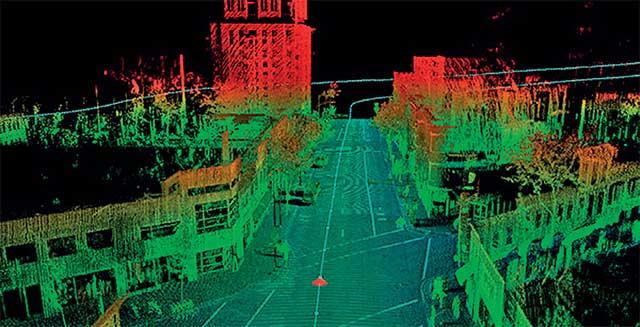DARPA has announced the MOABB program, which aims to design a LiDAR sensor that will reduce costs significantly while also coming in a smaller and lighter package. It is their goal to “turn a boutique technology into a world changer.”
The Modular Optical Aperture Building Blocks (MOABB) program’s approach is detailed in a press release DARPA published called “Pancaking the Telescope.” This new generation of light-based sensing systems will be designed by “packing the light-catching powers of bulky lens-filled telescopes onto flat, semiconductor wafers that are saucer-sized or smaller, featherweight and cheap to make.”
During phase one of the design process, researchers will develop the fundamental technology that allow a laser-scanning device to work without bulky optical equipment. DARPA’s release describes this fundamental technology as “speck-sized light-emitting and light-detecting cells capable of being readily integrated into larger arrays using typical semiconductor manufacturing processes.”
By DARPA’s description, that device is very similar to the SWEEPER LiDAR the organization announced earlier in the year, which integrates LiDAR functionality into a silicon microchip. As SPAR reported, similar solid-state solutions have been announced by Cal-Tech.
Phase two and phase three of the MOABB project “call for the integration of these cells into a 1 cm2 array and a 10 cm2 array comprising upwards of 100 and 10,000 unit cells, respectively.” The final product, which could be the size of a DVD or even smaller, may match or even improve on the performance of existing LiDAR devices.
Applications
DARPA’s intended use cases are primarily military, such as the creation of “foliage-penetrating imagers for spotting hidden threats—a breakthrough that could revolutionize situational awareness in contested areas.” As with much military technology, however, this development offers multiple civilian use cases.
“Every machine that interacts with the 3D world—whether it is a manufacturing robot, UAV, car, or smartphone—could have a chip- or wafer-scale LIDAR on it,” DARPA program manager Joshua Conway said in a prepared statement.
This means the cheap and light LiDAR technology could be deployed on drones for effective sense-and-avoid technology, allowing them to navigate in tight indoor spaces, or even close to sensitive infrastructure. It could be used for self-driving vehicles, as well as “precision motor control for robotic limbs and fingers, high-capacity light-based communications and data-transfer systems, and sophisticated gaming or training modules.”
DARPA compares this new breed of LiDAR to the GPS and motion-sensing accelerometers that have made their way into consumer and commercial devices in recent years. In other words, the MOABB LiDAR promises to make the technology widely affordable and small enough to fit in many consumer products, which means that it may help put 3D-sensing capabilities in your every day devices.
DARPA will host a “Proposers Day” at their headquarters in Ballston, Virginia on December 17, 2015 to provide “potential proposers” with detailed information on the program. Find out more here.






